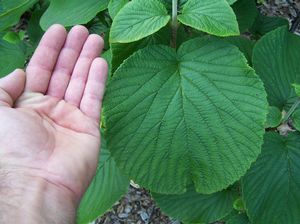View All Plants :: View All DECIDUOUS SHRUBS
Viburnum furcatum
Scarlet-leaved Viburnum
Plant Type:
DECIDUOUS SHRUBSViburnum furcatum - The Scarlet-leaved Viburnum is a large, rounded to broad spreading shrub with bold orbicular, pleated 6-inch by 4 to 5-inch leaves sporting serrated edges. It is rather rare in the U.S. White spring lace cap flowers are lovely. Berries lighten bright red late season overlapping with glorious shades of darker red and orange permeating the autumn leaves. Its large, bold and rounded leaves are a knockout. It appears to be very long-lived as it takes many years for flowering to commence. But the distinctive foliage alone makes this a worthy plant; the flowers are a wondrous event to await. Very reminiscent of our native Hobblebush, Viburnum lantanoides (formerly Viburnum alnifolium) we think that they are at least closely allied. And they flower simultaneously... could a hybrid be in the offing? Indeed, our native Hobblebush or Witch Hobble may be the long-separated ancestral New World relative of V. furcatum. Site in morning sun to three-quarters open shade in fertile soil - avoid harsh afternoon sun. More narrow and upright as a youth the Scarlet-leaved Viburnum will, as unfortunately true for too many of us, broaden with age. Established potted shrub from cutting.
Characteristics and Attributes for Viburnum furcatum
Season of Interest (Flowering)
- Spring
Season of Interest (Foliage)
- Spring / Summer / Autumn
Autumn Interest
- Fruit / Berries / Seed Heads
- Autumn Leaf Color
Nature Attraction
- Honey Bees & Native Bees
- Butterflies
- Songbirds
- Deer Resistant
Light
- Morning Sun / Afternoon Shade
- Dappled Shade
Attributes
- Screen
- Specimen
- Woodland
- Shrub Border
- Hedge
- Hedgerow
Growth Rate in the Garden
- Medium
Soil
- Draining
- Fertile
Origins
- Korea
- China
- Japan
Propagated By
- By Seed / Potted
Genus Overview: Viburnum
Common Name: Viburnum
Viburnum. This genus is full of fantastic, multi-season garden worthy shrubs. Garden heroes. Spring flowers, often large and showy, many with heady sweet fragrance are arranged in cymes. Some smell of musk (Viburnum dilatatum) while others produce no fragrance at all. Flowers are followed with berries. If late season and autumn berries are desired then planting two of a species will ensure fruit set; for instance, Viburnum dilatatum 'Erie' and V. dilatatum 'Michael Dodge' will pollinate each other and produce fruit. Viburnum cassinoides is closely allied with V. nudum; but if the flowering times do not overlap then there will be no fruit. However, if you plant V. nudum 'Winterthur' in proximity with V. nudum var. angustifolium, 'Longwood', 'Moonshine' or 'Pink Beauty' berries will abound. Another interesting example is V. lantana which crosses with V. burejaeticum and vice versa. Any V. plicatum f. tomentosum selection such as 'Shasta' or 'Shoshoni' will pollinate with all other V. plicatum f. tomentosum selections like 'Copper Ridges or 'Pink Beauty'. But if you were to plant two 'Shasta' side by side with no other V. plicatum f. tomentosum in near proximity then your effort will be fruitless. As with almost all in the universe of plants there are exceptions. There is one viburnum which appears to be self-fruitful, Viburnum setigerum the Tea Viburnum. Another interesting exception to the rule is Viburnum nudum 'Pink Beauty' which is also self-fruitful - a departure from its siblings. And on the other spectrum are two I can think of off-hand that are barren, Viburnum plicatum 'Roseum' and Viburnum plicatum 'Kern's Pink'. Oftentimes, the dwarf viburnums reamin in a juvenile state and do not produce fruit. All Viburnum of any size that do produce fruit are magnificent in the late season garden. And they feed all manner of birds. Larger, denser shrubs provide cover and nesting opportunities. Nearly all Viburnum have terrific autumn foliage colors, too. Viburnums are members of Caprifoliaceae. All prefer part to full sun and fertile soils. All are cutting grown. Many thanks to Gary Ladman of Classic Viburnums who generously set us straight regarding some of the details we had originally incorrectly lauded... ya can't know everything!


